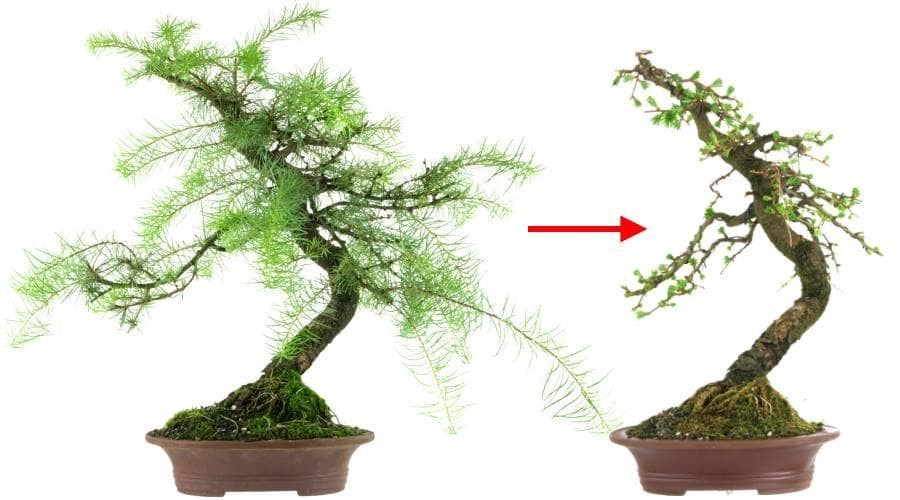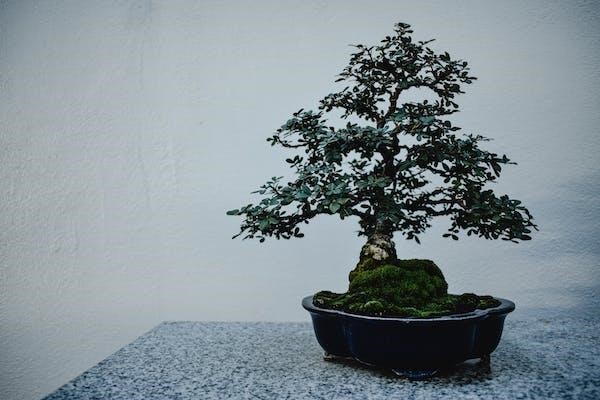How Often Do I Need to Prune a Japanese Larch Bonsai Tree
Prune a Japanese Larch Bonsai Tree every spring and autumn for optimal growth and shape. Japanese Larch Bonsai Trees require regular pruning for healthy growth and to maintain their desired shape.
If you’re pruning in spring and autumn, you facilitate new growth and maintain the tree’s aesthetics. Pruning involves removing dead or diseased branches, thinning out dense areas, and shaping the tree according to your desired Bonsai style.
It is crucial to use sharp and clean tools, such as bonsai shears, to ensure clean cuts and minimize damage.
Additionally, after pruning, it’s essential to water and fertilize the tree appropriately to support recovery and further growth.
By following a consistent pruning schedule, you can help your Japanese Larch Bonsai Tree thrive and display its beauty for years to come.
Why It Is Important to regular pruning for healthy bonsai growth?
Regular pruning plays a vital role in the growth and development of Japanese Larch Bonsai Trees. By removing dead or diseased branches, you can prevent the spread of harmful pests or diseases. Additionally, pruning helps to redirect the tree’s energy towards desired areas, promoting denser foliage and a more balanced appearance.
Furthermore, consistent pruning allows the bonsai tree to maintain its desired size and shape. As bonsai are miniature representations of full-sized trees, it is crucial to regularly shape and maintain them to achieve the desired aesthetic effect.
Pruning also encourages the growth of new branches and buds, giving the tree a lush and vibrant appearance.
Factors to consider before pruning a Japanese Larch Bonsai Tree
Before pruning your Japanese Larch Bonsai Tree, it is important to consider a few factors to ensure you achieve the best results.
- Pruning season: While pruning can generally be done throughout the year, it is recommended to prune deciduous bonsai trees, like the Japanese Larch, during their dormant period in late winter or early spring. This allows the tree to recover and heal more effectively.
- Pruning goal: Determine the specific goals you want to achieve through pruning. Whether it is shaping, thinning, or encouraging new growth, having a clear objective will guide your pruning technique.
- Pruning techniques: Familiarize yourself with the various pruning techniques suitable for Japanese Larch Bonsai Trees. These may include maintenance pruning to remove excess growth, structural pruning to enhance overall shape, or pinching to encourage denser foliage.
- Tools and equipment: Ensure you have the proper tools and equipment for pruning, including sharp bonsai scissors, concave cutters, and wire cutters. Keeping your tools clean and properly maintained is essential to prevent the spread of diseases.
How Often Should You Prune Your Japanese Larch Bonsai Tree?
Pruning is an essential practice in bonsai tree care, and the Japanese Larch Bonsai Tree is no exception. Regular pruning helps maintain the desired shape and size of your bonsai tree, as well as promotes healthy growth and development.
So, how often should you prune your Japanese Larch Bonsai Tree? Let’s find out.
Factors That Influence The Pruning Schedule
The frequency of pruning your Japanese Larch Bonsai Tree depends on several factors. By considering these factors, you can determine the appropriate pruning schedule and ensure your bonsai tree thrives.
Season:
Bonsai trees, including the Japanese Larch, have specific periods during which they should be pruned. For Japanese Larch Bonsai Trees, pruning is typically done during late winter or early spring, just before new growth starts. This timing allows the tree to recover quickly and take advantage of the upcoming growing season.
Growth Stage:
The growth stage of your Japanese Larch Bonsai Tree also plays a crucial role in determining pruning frequency. During the early stages of its development, your bonsai tree will require more frequent pruning to shape its structure and encourage branching. As the tree matures, the frequency of pruning can be reduced to maintenance pruning.
Health and Vigor:
A healthy and vigorous Japanese Larch Bonsai Tree may require more frequent pruning to control its growth and maintain its shape. On the other hand, if your tree is weakened or recovering from stress, it is advisable to minimize pruning to allow it to regain its strength.
Desired Bonsai Style:
The bonsai style you want to achieve with your Japanese Larch Tree can also affect the pruning frequency. Some bonsai styles, such as formal upright or broom, require meticulous pruning to maintain their distinct shapes. In contrast, more natural or informal styles may require less frequent pruning.
How You Can Offer Best Practices For Pruning Japanese Larch Bonsai Trees?
Pruning is an essential task when it comes to maintaining the health and shape of your Japanese Larch Bonsai tree. Proper pruning not only enhances the tree’s aesthetic appeal but also encourages healthy growth and development.
To ensure you achieve the best results, it is important to follow some of the best practices for pruning Japanese Larch Bonsai trees, such as considering the timing and seasonality, mastering the techniques for shaping and styling, and having the right tools and equipment.
Timing And Seasonality Of Pruning
Pruning at the right time is crucial for the overall health and growth of your Japanese Larch Bonsai tree. The ideal time for pruning is during the dormant season, which is typically in late winter or early spring before the new growth begins.
This allows the tree to recover quickly from the pruning cuts and minimize stress. However, it is important to monitor the weather conditions and avoid pruning during freezing temperatures or when there is a risk of frost.
Always ensure that your tree is healthy and in good condition before pruning to ensure successful results.
Techniques For Shaping And Styling The Tree Through Pruning
Pruning is not just about trimming away branches; it is an art form that allows you to shape and style your Japanese Larch Bonsai tree. There are various pruning techniques you can utilize to achieve different results. Some common techniques include:
- Thinning: This involves removing excess branches to improve air circulation and sunlight penetration, which promotes better overall health.
- Branch Placement: Pruning can help you control the placement and direction of the branches, creating a well-balanced and aesthetically pleasing design.
- Pinching: This technique involves pinching off the new growth with your fingers, encouraging the development of more compact and full foliage.
Remember to always use sharp and clean pruning tools to minimize damage and make precise cuts. It is crucial to remove any dead, damaged, or crossing branches to maintain the tree’s health and structure.
Tools And Equipment Needed For Effective Pruning
Having the right tools and equipment is essential for effective and successful pruning of your Japanese Larch Bonsai tree. Here are some of the tools you should have in your arsenal:
| Tool | Description |
| Bud Scissors | These small and precise scissors are perfect for trimming small shoots and buds. |
| Concave Branch Cutter | This specialized tool is used to make clean and concave cuts, allowing the wound to heal more quickly. |
| Root Hook | A root hook is handy for gently teasing out the roots during repotting, making sure they spread evenly. |
| Wire Cutters | Wire cutters are essential for safely removing wire used to shape and train branches. |
Tip: Remember to keep your tools clean and well-maintained to ensure they are in good working order when you need them.
What Signs Indicate That The Bonsai Need For Pruning?
Maintaining the health and shape of a Japanese Larch Bonsai tree is crucial, and signs indicating the need for pruning are key to ensuring its vitality and aesthetics.
Overgrown branches and excessive foliage are clear indicators that your bonsai requires attention.
Branches that have outgrown the desired shape or appear too long can lead to a crowded and unappealing look, hindering overall tree health.
Similarly, observing weak branches, characterized by frailty or an inability to support foliage, and identifying diseased branches with symptoms like discoloration or the presence of pests, is essential for timely intervention.
Beyond functional aspects, aesthetic considerations play a role in determining when to prune. Strategically pruning for visual appeal, addressing imbalances, and refining the overall shape through techniques like branch trimming and crown thinning contribute to the bonsai’s beauty and balance.
How To Create And Maintain A Desired Bonsai Shape Through Pruning?
Creating and maintaining a desired bonsai shape requires careful and ongoing pruning. Here’s a step-by-step guide to help you achieve the perfect shape:
Begin by visualizing the desired shape: Take some time to visualize and decide on the ideal shape you want your Japanese Larch bonsai tree to have.
Assess the tree’s structure: Evaluate the existing branches and foliage of the tree. Identify any branches that need to be removed or shortened to achieve the desired shape.
Start pruning: Using clean, sharp tools, carefully remove the unwanted branches or foliage. Trim any excessively long branches and create a balanced canopy.
Monitor growth: Regularly observe the tree’s growth and make adjustments as needed. Continue to prune selectively to maintain the desired shape and promote healthy growth.
Remember the basics: Along with pruning, ensure your bonsai tree receives adequate sunlight, water, and fertilization. These factors play a vital role in its overall health and growth.

Credit: www.bonsai-shop.com
Frequently Asked Questions
How Often Should I Prune A Japanese Larch Bonsai Tree?
Prune your Japanese Larch Bonsai Tree once a year during the late winter or early spring when it is dormant. Pruning at this time allows the tree to recover quickly and promotes healthy growth during the growing season.
When Is The Best Time To Prune A Japanese Larch Bonsai Tree?
The best time to prune a Japanese Larch Bonsai Tree is during the late winter or early spring when it is dormant. Pruning during this time ensures that the tree is not actively growing, reducing the risk of excessive bleeding and allowing the tree to heal quickly.
What Are The Benefits Of Pruning A Japanese Larch Bonsai Tree?
Pruning a Japanese Larch Bonsai Tree has many benefits. It helps maintain the tree’s shape and size, promotes healthy growth, and enhances the tree’s overall aesthetic appeal. Regular pruning also allows you to remove any dead or diseased branches, improving the tree’s overall health and vitality.
Can I Prune A Japanese Larch Bonsai Tree During The Summer?
It is not recommended to prune a Japanese Larch Bonsai Tree during the summer. Pruning during this time can cause excessive bleeding and stress to the tree, as it is actively growing. It is best to prune the tree during its dormant period in late winter or early spring.
Conclusion
To maintain the health and beauty of your Japanese Larch Bonsai tree, regular pruning is essential. By following a pruning schedule and removing dead or excess branches, you can encourage new growth and maintain its shape. Remember to prune your bonsai during the appropriate season and be mindful of its specific needs.
With proper care and attention to pruning, your Japanese Larch Bonsai tree will thrive for years to come. So, grab your pruning shears and start shaping your bonsai masterpiece today!

